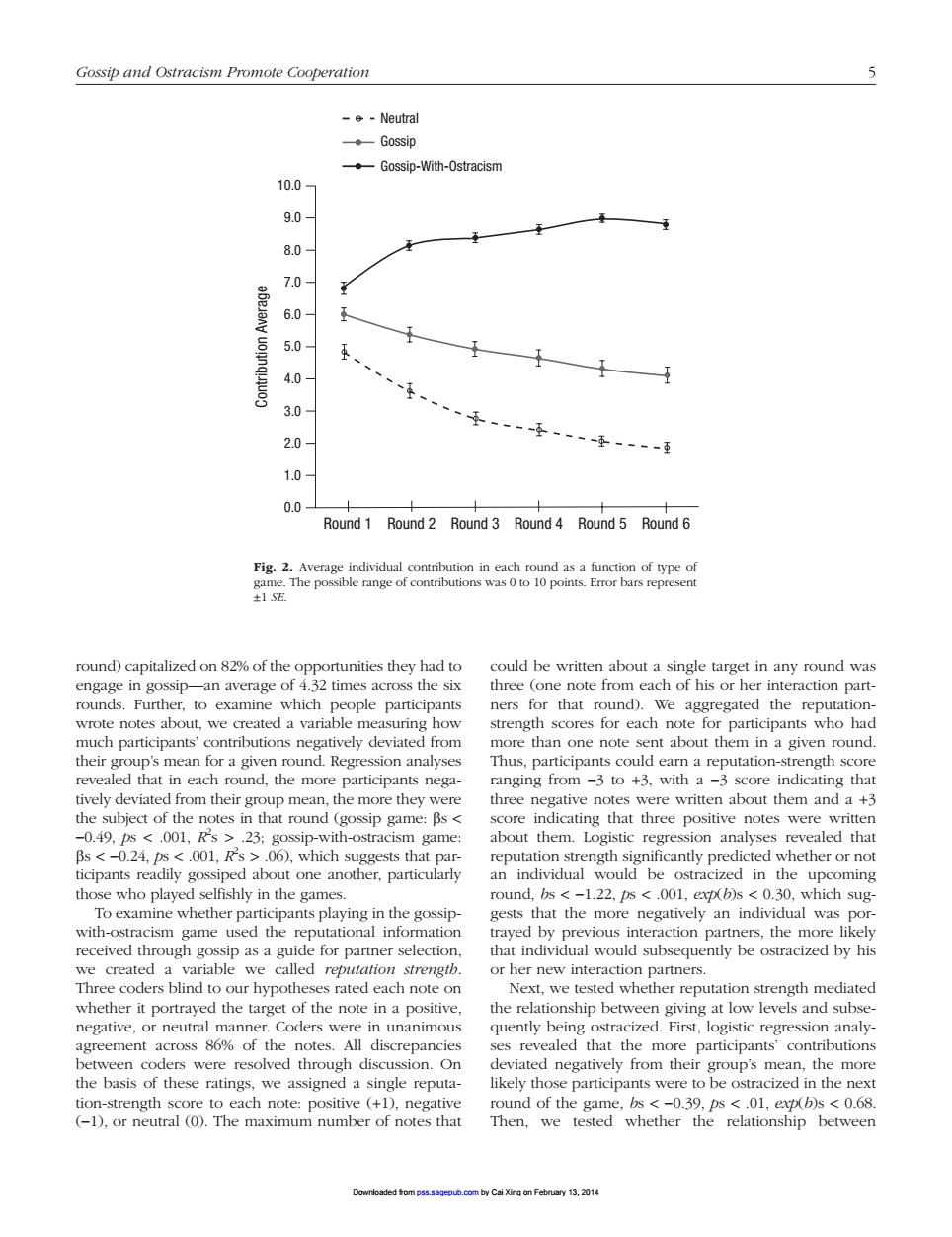正在加载图片...

Gossip and Ostracism Promote Cooperation -e-Neutral ◆-Gossip Gossip-With-Ostracism 10.0 9.0 8.0 6.0- 5.0 玉、 4.0 3.0 2.0 1.0 0.0 Round1 Round 2 Round 3 Round 4 Round 5 Round 6 ortunities they had to could be written about a single target in any round was three (one note from each of his or her interaction part- rounds.Further,to examine which people participants ners for that round).We aggregated the reputation wrote notes about,we created a varia able m streng th scores for each note for participants who ha revealed that in each round.the more participants neg ranging from-3 to +3,with a-3 score indicating that tively deviated from their group mean,the more they were three negative notes were written about them and a +3 heub水tot the notes in that round (gossip game:Bs 6s s-0.24.s them. ticipants readily gos iped about one another,particularly those who played selfishly in the games round,bs <-1.22,ps <.001,exp(b)s 0.30,which sug cipants playing in the gossip gests that the more negatively an indiv dual was teraction p or her new interaction partners. Three coders blind to our hypotheses rated each note on Next,we tested whether reputation strength mediated whether it portrayed the target of the note in a positive. the relationship between giving at low levels and subs or neutra 6nn un:ani logistic regression analy betveen coders were resolved through discussion.On deviated negatively from their group's mean.the mor the basis of these ratings,we assigned a single reputa- likely those participants were to be ostracized in the next tion-strength score to each note:positive (+1).negative round of the game,bs <-0.39.ps <.01,exp(b)s <0.68 (-1),or neutral (0).The maximum number of notes tha Then,we tested whether the relationship between 13.201 Gossip and Ostracism Promote Cooperation 5 round) capitalized on 82% of the opportunities they had to engage in gossip—an average of 4.32 times across the six rounds. Further, to examine which people participants wrote notes about, we created a variable measuring how much participants’ contributions negatively deviated from their group’s mean for a given round. Regression analyses revealed that in each round, the more participants negatively deviated from their group mean, the more they were the subject of the notes in that round (gossip game: βs < −0.49, ps < .001, R2 s > .23; gossip-with-ostracism game: βs < −0.24, ps < .001, R2 s > .06), which suggests that participants readily gossiped about one another, particularly those who played selfishly in the games. To examine whether participants playing in the gossipwith-ostracism game used the reputational information received through gossip as a guide for partner selection, we created a variable we called reputation strength. Three coders blind to our hypotheses rated each note on whether it portrayed the target of the note in a positive, negative, or neutral manner. Coders were in unanimous agreement across 86% of the notes. All discrepancies between coders were resolved through discussion. On the basis of these ratings, we assigned a single reputation-strength score to each note: positive (+1), negative (−1), or neutral (0). The maximum number of notes that could be written about a single target in any round was three (one note from each of his or her interaction partners for that round). We aggregated the reputationstrength scores for each note for participants who had more than one note sent about them in a given round. Thus, participants could earn a reputation-strength score ranging from −3 to +3, with a −3 score indicating that three negative notes were written about them and a +3 score indicating that three positive notes were written about them. Logistic regression analyses revealed that reputation strength significantly predicted whether or not an individual would be ostracized in the upcoming round, bs < −1.22, ps < .001, exp(b)s < 0.30, which suggests that the more negatively an individual was portrayed by previous interaction partners, the more likely that individual would subsequently be ostracized by his or her new interaction partners. Next, we tested whether reputation strength mediated the relationship between giving at low levels and subsequently being ostracized. First, logistic regression analyses revealed that the more participants’ contributions deviated negatively from their group’s mean, the more likely those participants were to be ostracized in the next round of the game, bs < −0.39, ps < .01, exp(b)s < 0.68. Then, we tested whether the relationship between Contribution Average 0.0 9.0 8.0 7.0 6.0 5.0 4.0 3.0 2.0 1.0 10.0 Round 1 Round 2 Round 3 Round 4 Round 5 Round 6 Gossip-With-Ostracism Gossip Neutral Fig. 2. Average individual contribution in each round as a function of type of game. The possible range of contributions was 0 to 10 points. Error bars represent ±1 SE. Downloaded from pss.sagepub.com by Cai Xing on February 13, 2014